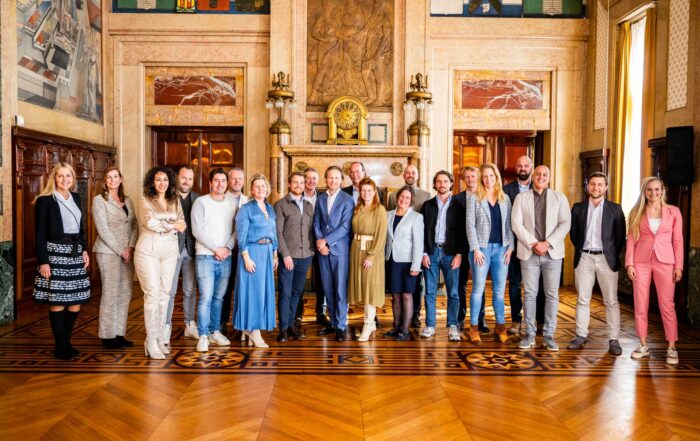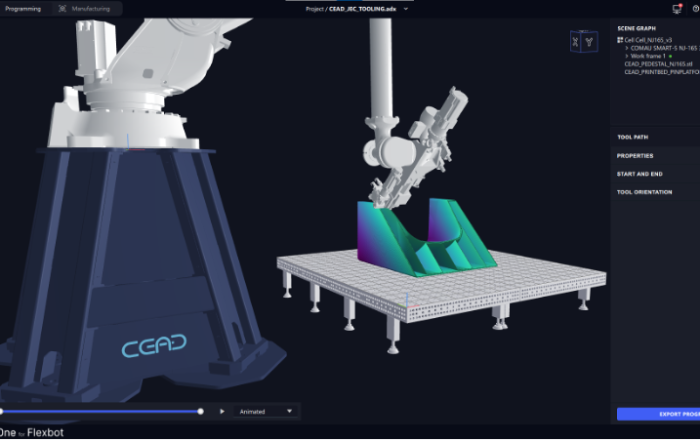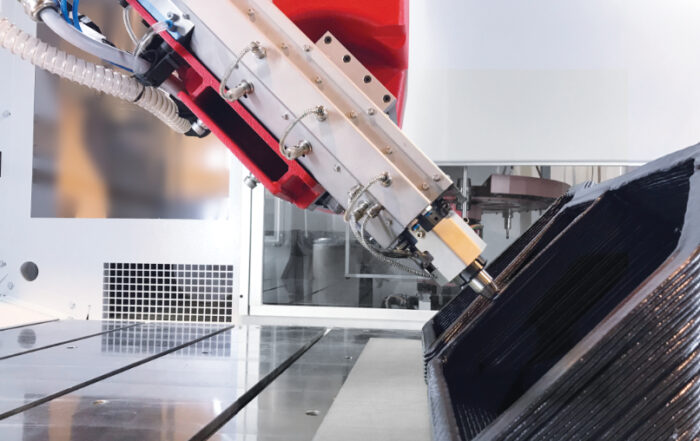
Photo credit: IBK/D-BAUG, GKR/D-ARCH, ‘RIBB3D’ – ETH Zurich’
Moving from traditional production methods to large format additive manufacturing (LFAM) requires a shift in your current business processes, strategy and way of thinking. From the materials that you are using to the design process and even possible adjustments to the production facility, it is time to rethink everything.
This article elaborates on 10 factors that are generally considered of interest for companies that start with additive manufacturing. Going through these 10 steps benefits the transition from traditional production to additive manufacturing and subtractive manufacturing. Continue reading for all the factors or click on one of them from the table below to dive into the subject directly.
Content of this article
Click on one of the 10 hyperlinks to jump directly to this topic or continue scrolling to read the whole article. In the video embedded, CEAD CTO and co-founder Maarten Logtenberg dives into six of these considerations.
- Determine the targeted benefits of LFAM
- Converting the design to additive manufacturing
- Consider the properties of thermoplastic composite
- Putting design and material together
- Selecting the AM solution for your application
- Consider adjustments to the production facility
- Installing and calibration of the machine
- Large format additive manufacturing training
- Starting continuous in-house LFAM
- A partner that grows as your company grows
1: Determine the targeted benefits of LFAM
The starting point of LFAM can usually be found in the benefits of this production method compared to traditional manufacturing. It is therefore not surprising that these advantages define the following steps in the LFAM selection process. To understand the possible benefits of LFAM for your organization, we need to analyze the entire use case and determine which factors apply to your application. Companies starting with LFAM usually list one or more of the following advantages as motivation for LFAM:
- Large format additive manufacturing requires less manual labor than traditional methods. The current staff shortages worldwide drive the need for innovation even further.
- The supply chain can be reduced using large format additive manufacturing. The ability to print molds, structural end parts and non-structural end parts significantly reduces both the dependence on third parties and the size of necessary inventory.
- Extending global lead times motivates companies to produce locally. LFAM enables companies to do so, reducing the number of transportation movements necessary for production.
- While a shorter supply chain and fewer transportation movements already contribute to a smaller carbon footprint, LFAM has more benefits for companies that seek to produce more sustainably. LFAM provides the possibility to ‘close the loop’ by using recycled material for 3D printing.
- By offering the benefits listed above, LFAM provides a more cost-effective production method in the long term. Large format additive manufacturing is thus also financially interesting.

2: Converting the design to additive manufacturing
Design made for traditional manufacturing methods can not be applied one-to-one to 3D printing. For instance, 3D printing enables the integration of multiple components into the same design. Whereas traditional methods would require these components to be assembled manually. Omitting joints via riveting or welding not only ensures an end product with higher strength but also saves valuable time.
Because of the differences in the design principles, the design process must be adapted to designing for additive manufacturing. CEAD happily helps companies and organizations with this adaptation.
One way of doing so is through pilot projects that our application team conducts to assess the technical and commercial feasibility of the application of LFAM. Design and printing strategies are central concepts during the projects. We select the right printing strategy based on the design.
Another example of CEAD’s support with this step can be found in the training that new owners of our industrial 3D printing systems receive from the support engineers. The training does not only focus on handling the hardware and software supplied by CEAD, but also on designing for 3D printing.
3: Consider the properties of thermoplastic composite
Organizations that start large format additive manufacturing are usually familiar with various steel or thermoset composites. During their transit to LFAM, they discover the world of thermoplastic composites. CEAD’s printheads are developed to process a wide range of thermoplastic fiber-reinforced materials. From high-performance materials reinforced with carbon fibers to commodity materials reinforced with glass or natural fibers.
Aspects such as strength, stiffness, UV resistance, flammability, flame retardancy and lifespan differ for thermoplastics, thermoset composites and materials such as steel. The properties of fiber-reinforced thermoplastics provide a lot of new possibilities.
At CEAD we are continuously testing materials together with our clients and material suppliers. During these tests, we do not only dive into a material’s printing ability but also into its characteristics, such as strength. We think it is vital to test these materials as each application has different requirements and therefore demands different material.
The use of thermoplastic composites for additive manufacturing has several advantages. First of all, the material provides a high corrosion and chemical resistance. Additionally, thermoplastics can be recycled, enabling for more sustainable production processes. Finally, CEAD provides its clients with a large knowledge base of all material tests that is constantly being expanded.
Pellet versus filament large format 3D printing
Most 3D printers today use filament as the raw material for making 3D prints. Before the filament can be used, it needs to be processed. This process is known as filament extrusion and it involves the conversion of raw plastic pellets into a filament wire.
CEAD’s additive manufacturing systems use plastic pellets instead of filament. Unlike filament extruders, pellet extruders use a screwing method to melt and transport pelletized material from the barrel through a heated nozzle (die). Pellets are fed into a feeder inlet. They are then pushed through a barrel with multiple heated sections where they are heated to melt.
Once softened to the desired consistency, the screw mechanism creates enough pressure in order to force the material out through a nozzle onto a platform, creating 3D prints layer by layer. The process is more complex when compared to filament extrusion but it does have several benefits, such as lower costs, higher production speed, and a higher availability of materials.
4: Putting design and material together
The decisions made concerning design, printing strategy and 3D printing material in the previous steps come together in the pilot project. During this project, we will investigate important aspects of the application such as the design, required material, and printing strategy. For instance, specific materials might act differently when printed at a 45-degree angle. The pilot project provides the perfect opportunity to test this in practice.
A pilot project starts with a cost-effective quick analysis of the overall difficulty of the project. The complexity, printing strategy, object size, and material selection are taken into account during the quick analysis.
The overall possibilities for a pilot project are endless. Pilot projects are always customized to your needs. Both additive and subtractive needs can be added to the pilot project, depending on the application. The project is typically ranged between a material test or a full-scale end-use part.
The duration of a pilot project depends on its size and complexity. Smaller pilot projects can be realized in one phase, think for example of selecting the printing material. Larger pilot projects are cut into three phases in order to minimize the risk for both parties. After each phase, a ‘go/no go’ moment takes place, which allows both parties to control the project.
5: Selecting the AM solution for your application
The first selection of possible large scale 3D printing solutions is made during the start of the pilot project, in the quick analysis. The next steps guide the customer to the ideal 3D printing set-up for their particular application. Once the feasibility has been proven, the ideal machine can be optimized and customized.
CEAD designs and delivers a complete Flexbot solution: from the robots themselves to extruders, the print bed, nozzles, and a dryer. Our specialists help to put together a system that fits your needs. The Flexbot scales along with you, in the sense that if you create large prints you can select a print track over a pedestal. If you plan on printing with rough material, a more powerful extruder can be selected. The Flexbot is based on a modular design.
Another aspect of flexibility can be found in the nozzle heads. The nozzle size can be determined per extruder. Depending on the width that you would like to print and the extruder itself, you can adjust the nozzles from 2 to 25 mm.
6: Consider adjustments to the production facility
Not all production facilities are instantly ready for the installation of a large scale additive manufacturing machine. Before the machine will be shipped to your location, CEAD designs possible layouts for the final installation.
Additionally, simulations are created to provide an accurate preview of the machine. During this process, we determine whether the machine fits the production facility, whether the necessary equipment is available and if adjustments are required.

7: Installing and calibrating the machine
The most exciting part of the process has arrived: the installation and calibration of the system at your production facility. This step focuses on the accuracy that the final system will be able to print with. It is important that the LFAM supplier is able to deliver an accurate solution that is calibrated to your facility.
Before the robot is shipped, CEAD conducts a Factory Acceptance Test (FAT) in-house to guarantee that the system works according to the standards that we expect/demand from our systems. The system will be assembled according to the needs that were determined during the pilot project.
Subsequently, the robot will be shipped, assembled and tested at your facility during the installation phase, which includes the Site Acceptance Test (SAT). During this test, the functionality and safety of the robot is tested at the customer site.
The final part of the installation can be found in the calibration of the system, performed by our software engineers. CEAD strives to revolutionize the possibilities of additive manufacturing. Central in this strive is the accuracy of our large scale 3D printers.
Various aspects of the AM solution are calibrated with Sinumerik Direct Control and our laser tracking system, such as the linear tracks, robot arm accuracy, and the sag of the robot arm is corrected. Click to read more about improving LFAM accuracy with laser tracking.
8: Large format additive manufacturing training
To unlock the full potential of our solutions, one must become familiar with the possibilities of large scale 3D printing. This is why CEAD helps clients with personalized training, both in-house at our production hall, as well as on-site at your production facility. Training is provided to obtain the knowledge and skills required to operate the specific solution that was purchased.
CEAD offers various possibilities for large scale 3D printing training. The most common training is the obligatory training that comes with the purchase of the Flexbot, which focuses on our robot-solution. Besides this, CEAD also offers optional training for pellet extruder clients.

The content of the pellet extruder training and how it is conducted can be customized based on the preferences of the client. CEAD is able to provide the training through an online call, at our production hall, or on-site. The current article elaborates on the training that is given to new owners of the Flexbot solution.
CEAD does not differentiate between starters, advanced or other types of training, all clients receive the same level of training. However, the training is personalized as much as possible. Think for example of engineers that are familiar with CNC machines, who require different/less training than people who are new to the machinery.
Generally, the training is followed by up to 5-6 people. This is due to the ideal trainer-to-trainee ratio of 1 to 3. Flexbot training is usually conducted by two application/customer support engineers. In our experience, a maximum of three persons per trainer provides the optimal experience for the trainees. If necessary, it is possible to request training with higher capacity.
9: Starting continuous in-house LFAM
We believe that after the machine has been installed at the customer, the LFAM provider keeps playing a vital role in the successful implementation of the solution. While the knowledge and machine are at your disposal, you might bump into obstacles/challenges on your LFAM journey. That is why CEAD’s dedicated and experienced support engineers ensure the highest possible machine uptime.
They do so in two ways. Firstly, the support team is experienced with worldwide support and is thus able to provide support when needed. They either provide a solution from a distance (online, through the knowledge portal, or in a video call) or visit your facility when needed. Secondly, CEAD has an extensive stock of spare parts that can be ordered online and will be shipped to your facility upon request.
Our team of experts is dedicated to establishing a long-term relationship in order to provide our customers with a fruitful LFAM experience. The team has extensive experience with additive manufacturing and in-depth knowledge of the technology. We can anticipate various scenarios or challenges that you might encounter and are able to provide a fitting solution or strategy to move forward. In case anything happens, we are trained to quickly identify the problem and come up with long-lasting solutions.
10: A partner that grows as your company grows
As a company grows, the production capacity grows simultaneously. If initially one robot printing system matched the AM needs of a company, over time, a growing production might require the purchase of additional machines.
The support engineers from CEAD have witnessed this growth at companies on several occasions and thus know what needs might develop further in the future. Furthermore, the support team understands that continuity is of importance. They will provide continuity not only by providing support to increase uptime, but also by being available for the training of future staff.
It is of crucial importance to select an additive manufacturing supplier that develops with your company. Together with our partners, CEAD is on the frontier of large scale additive manufacturing. We work closely with several research institutions (such as Technische Universität Dresden, ETH Zürich, Technical University of Munich and ICD Stuttgart) to continuously innovate additive manufacturing while being able to provide creative solutions for our customers and their applications.

Starting with large format additive manufacturing
The way the machine is configured by the supplier is of great importance for particular applications. For example, the maritime sector requires different dimensions of the prints than, say, automotive. This is reflected in the size of the machine, the print bed and the choice between a pedestal or robots on a track.
A provider that is familiar with the application of additive and subtractive manufacturing in various sectors is thus important. CEAD has been developing large scale 3D printing technology for over eight years. From stand alone printheads that are connected to an existing robot arm to complete gantry or robot solutions, delivered and installed worldwide.
With passion for technology and innovation, we are driven to find creative solutions for our clients and their applications. Helping them to transform their business activities with our technology. Please feel free to reach out to us for any questions about large scale projects.
Continue reading on large format additive manufacturing
Three groundbreaking world conquerors nominated for 39th edition Rotterdam Entrepreneur Award
This article was originally written in Dutch, click to read the original version in DutchCEAD,Van Donge & De Roo and Hollandia Services are the finalists of the Rotterdam Entrepreneur Award 2024. The nominees for the [...]
What staff do you need for large format additive manufacturing (LFAM)?
When it comes to implementing a new technology, involving employees during the adoption process is essential. While our large format 3D printing solutions focus on automation, people are still a crucial element. With new [...]
3D Printing in boat manufacturing
In recent years, the Netherlands has become one of the trailblazers in maritime technology, specifically with its adoption of large format 3D printing in boat manufacturing. This innovative approach to shipbuilding transforms the traditional [...]
CEAD and ADAXIS Integration Redefines Efficiency in Robotic Large Format 3D Printing
JEC World Paris, 5th March, 2024 - CEAD, frontrunner in robotic large format 3D printing solutions, is thrilled to announce a pivotal collaboration with ADAXIS, a rapidly fast-growing robotics software company. This strategic partnership aims to strengthen [...]
Large format 3D printing with PIPG
If you are looking for a cost-effective, easy to use and beautiful printing material for your large format 3D printer, PIPG is the right material. PIPG, or Post-Industrial PET-G, is an innovative recycled material [...]
3D printing with pellet extruders versus with filament
In all processes of industrial manufacturing, efficiency is key, and speed is paramount. Industrial 3D printing helps companies to improve and speed up their manufacturing processes by rapid prototyping, unlocking fast customization and by [...]








